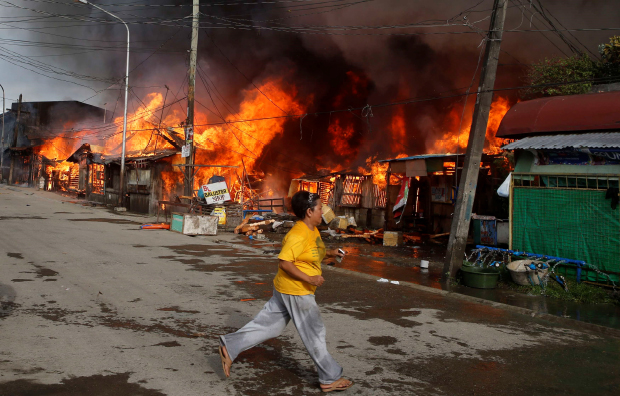TENSION CONTINUES to run high in Zamboanga after a faction of the Moro National Liberation Front (MNLF) stormed the city last September 9. The armed incursion has left the city at a standstill, with over 82,000 displaced families, 110,000 evacuees and over 100 deaths as of press time.
The faction of the MNLF, led by Commander Habier Malik, infiltrated the four barangays of Rio Hondo, Talon-Talon, Sta. Barbara and Sta. Catalina, attempting to hoist the Bangsamoro flag in Zamboanga City Hall.
The faction intended to assert the independence of the Bangsamoro Republik, which the Philippine government has refused to recognize in spite of the proclamation issued by MNLF Chairman Nur Misuari in August of this year. Misuari declared Davao the republic’s capital and staked claim over Mindanao, Basilan, Tawi-Tawi and Palawan, as well as Sabah and Sarawak in Malaysia.
Presidential spokesperson Edwin Lacierda reiterated that the Philippine government is striving for a peaceful resolution of the conflict and will not tolerate any further violence. “Let it be clear to those defying us that they should not entertain the illusion that the state will hesitate to use its forces to protect our people,” he said during a news briefing held last September 12.
Lacierda stressed, “There is only one independent republic of the Philippines.”
As of press time, the majority of the fighting has ceased, forcing the MNLF to only control small pockets of the city. All hostages were freed by September 26.
Misuari’s “war for independence”
In a phone interview with Rappler, Malik explained that the siege was a reaction to the recent developments in the peace talks between the Aquino administration and the MNLF’s rival group, the Moro Islamic Liberation Front (MILF). The MILF and the Aquino administration are close to completing peace talks without the participation of the MNLF.
Malik said that previous promises by the government for development in the Autonomous Region of Muslim Mindanao (ARMM) were not kept and that there are aspects of the 1996 Peace Agreement between the Philippine government and the MNLF that have not been fulfilled. “The MNLF’s 1996 agreement with the Philippines cannot be sidestepped by a new agreement with the MILF,” he said.
The Misuari-led MNLF has been fighting for the liberation of the Bangsamoro since the early 1970’s. In response to this, the Philippine government issued Republic Act 6734 in 1989, thereby formalizing the ARMM under the 1987 Constitution.
However, due to differences in ideology, a group led by Hashim Salamat broke away from Misuari and formed the Moro Islamic Liberation Front (MILF).
Attempts at peace talks between the government and the MILF were carried out across different administrations, but it was only in April of 2012 that a breakthrough in the peace discussions was achieved. However, this was carried out without the participation of the MNLF.
“Misuari felt left out from the agreement… They weren’t speaking to him. Moreover, [he] was angered by the government’s disregarding of his proclamation of independence that same year,” said Fr. Edwin Castillo, SJ, who is based in Ateneo de Zamboanga.
“Is [the conflict] still about religion? We don’t know. But we know that Misuari is not happy about being excluded from [the movement] that he himself had started,” he added.
It should also be pointed out that divisions exist within the MNLF itself. “The MNLF has not been one organization nor one voice,” Presidential Adviser on the Peace Process Teresita Deles told ANC.
She said that the leaders of other MNLF factions were saddened by the violence in Zamboanga and that “many of them actually welcome the framework agreement… They want peace, they want development.”
Various accounts from the current hostages show that many of the MNLF’s fighters are teenagers. GMA News reported that the youngest of the soldiers is only 14 years old and that many of them were paid and tricked into going to Zamboanga.
Zamboanga Mayor Beng Climaco said that the conflict is rooted in misdirection. “This is an issue of those misguided people whose ideologies had been founded with the use of arms, ultimately to inflict terror to our people,” she said in a press conference held on September 15.
Fr. Castillo also remarked that Chairman Misuari could have attacked any major city in Mindanao, but likely chose Zamboanga for tactical purposes. “Zamboanga is very strategic, is very close to Sulu, which is where the faction is based. Media coverage in Zamboanga is also very accessible, and Misuari wants media attention.”
Kalinaw Mindanao
University President Fr. Jett Villarin, SJ has called for solidarity among all of the Ateneo schools to help raise resources for the displaced families.
Concerned Ateneans have formed Kalinaw Mindanao, a student action group geared towards the provision of aid, campaigns for peace and the promotion of consciousness in light of the violence in Zamboanga. The group has set up stands for donations in Gonzaga Hall and Cervini Drive, organized a forum for awareness and release updates online via their Facebook page.
Tats Quiblat, convenor of Kalinaw Mindanao, says that Ateneans have been very supportive and eager to help out. “I am proud to say that Kalinaw Mindanao has been able to collect 217,799.65 pesos worth of cash donations since the beginning of our operations last Monday. We are also planning to hold another forum with a speaker from the MNLF and a representative from the Department of Islamic Studies, UP (University of the Philippines) Diliman to hopefully address other dimensions of the issue,” he said.
School of Social Sciences Secretary-Treasurer Marvin Lagonera, who hails from Zamboanga, has also been closely following the events. “The situation is very unpredictable. People are scared and in panic… My family is safe but it distresses them that they have no idea when this violence will end,” he said.
He concluded in a mix of English and Filipino, “They’re always hoping that it will be resolved but it seems as though there is no good news and no progress.”




